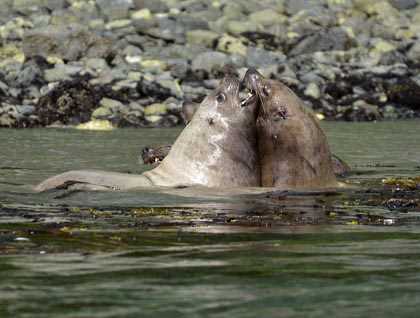The fog horn could be heard throughout the National Geographic Sea Lion as she made her way toward our morning destination of the Inian Islands. This small group of islands marks the entrance of Cross Sound where much of the northern tidal waters enter Southeast Alaska from the Pacific Ocean. Tidal ranges in Southeast Alaska can reach changes of over 20 feet of water moving through a very narrow entry causing phenomenal current, standing waves and many circling eddies. The current moon was moving towards a new moon, nearly halfway, which provided for a more gentle tidal change, a blessing for all Zodiac drivers! Our morning was spent in our inflatable crafts exploring the nutrient rich waters of the passages in and around the Inian Islands.
As drivers prepared their gear, including a GPS, the fog began to lift. Slowly the very tops of the Fairweather mountain range could be seen from the back deck of the National Geographic Sea Lion. As all inflatable crafts left the mother ship and headed deeper into cluster of islands called the Inians, a great landscape opened up before our eyes. The Brady Glacier and Taylor Bay could be seen with the Pacific side of the Fairweather range which dominates Glacier Bay National park just to the right and behind. Our goal was to make our way into a well-known hall out area for Steller sea lions. As if on cue, we could hear the roaring of the sea lions as we approached one of the central islands in the Inians. A group of males in a variety of sizes were sitting, resting, and swimming at the base of the island and very curious about the approaching small black boats! From this opening each Zodiac continued on its course exploring for nearly two hours per round, moving in and out of “secret” places where we found resting sea otters who were undisturbed by our presence. We then continued exploration of smaller and larger islands; we kept a watch, waiting for the incoming tide to begin its push through Cross Sound and through this area often called the land of a thousand islands. The fog from the morning continued to work its veils over the islands, weaving delicate patterns of morning light over the landscape. Cameras were working hard in every vessel as we approached many, many bald eagles, who were watching us watching them! The waters around us were obviously well-known to all animal life as an enormous food source! Birds, whales, sea lions, and seals all were here to make an excellent living off of the rich resource available for the taking.
After a massive amount of images had been made we reluctantly returned the National Geographic Sea Lion and made a very short passage, during lunch, to our afternoon anchorage just off of George Island. The sun was out and our afternoon began to heat up very noticeably. Hiking and kayaking were offered with the option to do both. Although, the real highlight for everyone coming ashore were two delightful experiences. One was a very large and well-built swing! Hidden up a short trail just off of the beach a swing big enough for two small humans was hung between two Sitka spruce trees. Every hiking group made a stop at the swing and took a turn swinging out over a steep cliff with a view of Cross Sound and many rounded cupcake islands. Meanwhile on the beach a swimming party had begun in earnest! A sunny afternoon on a beach with no barnacles, what a way to finish our afternoon! Almost half of our group had swim suits, shorts, and t-shirts, or whatever clothing was available that could go into the clean refreshing waters around George Island, followed, of course, by a rest in the sun on the beach. We had been blessed with fabulous weather and good tides all day and as the National Geographic Sea Lion left our anchorage in Cross Sound, we wondered and marveled at what would be around the corner in this place of a thousand islands; often thought of as tall mountaintops tipping into the sea.







